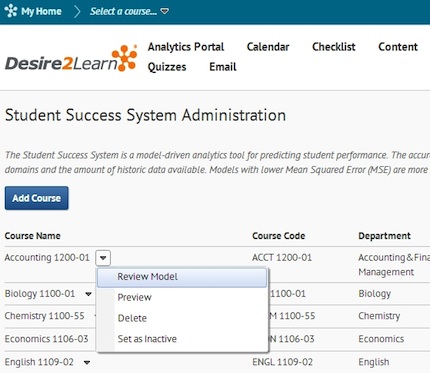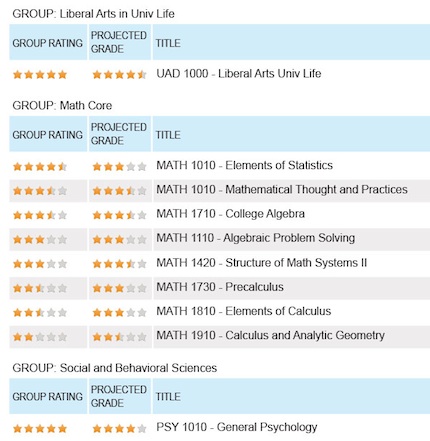Desire2Learn Learning Suite Update Beefs Up Predictive Analytics
- By Dian Schaffhauser
- 05/07/13
Desire2Learn has introduced new functionality to its learning management suite, including new predictive analytics tools, improvements on the mobile and e-portfolio fronts, and an important addition in the area of accessibility.
In January the company announced its acquisition of Degree Compass, technology developed at Austin Peay State University designed to help students and advisors make more informed choices in course selection. Now the program will be made more broadly available for use by other institutions beyond those already running it. In addition, Desire2Learn is launching Student Success System, which provides data that can help an instructor identify overall course risks and student progress.
"Predictive analytics have transformed other industries, yet to date, it has been missing from education," said CEO and President John Baker. Noting that students are struggling "to figure out their pathways through life and education," he added that the new release introduces "a key to unlocking the power of predictive modeling in the context of the educational experience." The goal: to "leverage analytics and insights to drive those deeper engagements, deeper understandings, so we can really have a big impact on the educational experience. I truly believe the outcomes will be better retention, better grades, better engagement."
According to the company, the Student Success System provides instructors with predictive data visualizations that provide a way to compare student engagement in order to expose overall course risks and monitor learner progress. The company emphasized in a statement that although the new application addresses at-risk students, it "also provides important insights for all students and offers solutions targeted to improve learning outcomes for this vast majority of students." The point is, said Baker, is to help faculty recognize when students are heading "down a path that isn't going to lead to success" in order to intervene.
Baker said the algorithm being used by the Success System has a couple of aspects. The first part "is based on research findings — i.e. knowing beforehand which data elements tend to boost accuracy of predictions — as well as pooled historical data from multiple clients. We show 90 percent-plus accuracy for the first part of the algorithm. The accuracy is measured by comparing the results of the predictive algorithm on the training dataset."
The second part, he said, is "the generation of course-specific, institution specific" algorithms. "Unlike our competitors we generate customized predictive models for each and every course. Because there is wide variability in learning design, instructor teaching patterns, [and] student profiles, we believe that predictive models must be tailored to each course at each institution. The second part of the algorithm, therefore, is generated against historical data associated with a specific course at a specific institution. Depending on the quantity and quality of the available course-specific historical data, the predictive accuracy tends to range from 60 percent to 90 percent. We provide an administrative interface so that the institution can generate the course-specific models, assess the strength of the model, and then decide whether or not to the deploy the model."
Baker added that Desire2Learn "strongly discourages blind, automatic deployment of the course-specific models." The company is building an "interpretive practice" in its professional services group to help institutions learn how to interpret and apply the models.
As the Student Success System is deployed, Baker said, the company will set up control groups among those institutions that give permission, "similar to what occurs in clinical trials. Suppose we predict that a student is at risk of failing a course. Suppose that an institution takes action based on the prediction. Suppose that the student succeeds by passing the course. How do we know that our prediction (of failure) was correct?" he noted. This approach will help to confirm that the intervention — and not some other factor — contributed to the success. "One of the ways to get at the first question more rigorously is to set up a control group. With the control group we would make the predictions and merely observe the outcome."

Screen shot of the Student Success System in the Desire2Learn Learning Suite |
Tristan Denley, provost and vice president for academic and student affairs at Austin Peay as well as the inventor of Degree Compass, said the two analytics products are "mutually reinforcing." On one hand, he pointed out, "what Degree Compass is all about is to try to help students get into the right classes in the first place by analyzing previous grades and degree structure and all of that information. On the other hand, the Desire2Learn Student Success piece is all about trying to assist faculty and the students when they're actually inside the class, when they're involved in the semester of learning."
He developed the course recommendation technology in order to help students at the university "make better decisions about navigating their way through their degree program." The challenge for students at his school, according to Denley, is that more than half of them are first generation; 40 percent are adult learners. "Many of those students have never navigated their way through a degree program before." While all of them have the opportunity to work with an advisor every semester, "there are so many small decisions that go into working your way through a degree program, we wanted to bring as much technology to bear to inform those decisions as we could."
To use Degree Compass, the student goes to the secure side of the Web portal to see the courses recommended to them for their specific degrees. That includes courses available for the next semester as well as for the future. That same information is available to advisors as well. The user can set a filter to specify a specific branch campus, online only, face-to-face, evening, or other criteria.

Degree Compass, part of the Desire2Learn Learning Suite |
Along with that, they also get a star rating on the course to let them know how well the software believes that particular student would do in the course. Five stars identifies an ace; one star identifies potential or probable failure. That rating is intended to help them identify courses for which they're prepared or to warn them where they may struggle and might want to get extra tutoring or prepare in other ways. Advisors also see probable grades, information that currently isn't being made available to the students, because, Denley explained, "We didn't want it to be a self-fulfilling prophecy. That's not what it's about."
After two years of using Degree Compass, Denley said, the impact "has been quite startling." The use of the software as part of academic advising at the institution has directed students towards more classes in which they would more readily succeed. "What we've seen is that the proportions of A, B, and C grades moved by more than five standard deviations," he reported. The shift for students with Pell grants has been even more dramatic — to seven standard deviations. In other words, for nine out of 10 classes in which the program predicts the student will earn an A, B, or C, they achieve that grade in reality.
The system pulls data out of the university's student information and degree audit systems. From there, said Denley, "the system just self-calibrates. There really isn't any additional data entry."
Along with the analytics, there are other enhancements to the company's product line. Although Desire2Learn already supports mobile devices on multiple platforms, the latest release bolsters the company's Binder function. Binder is a reader that runs on iPads and allows the user to interact with PDF and Microsoft Office files, HTML, and other documents. With the update, Binder allows the student to take all course content and go offline with it, including being able to write on top of it, annotate it, share notes, and connect to other sources outside of the Desire2Learn environment, including to the contents of a Microsoft SkyDrive or Dropbox.com repository.
With this set of updates the company has also made its accessible HTML templates available on its Web site. As Baker explained, "You can actually import [a template] into any of our competitors' [products] or use it in our environment as a great way to create content that's more accessible. We're shifting away from having just a platform that's more accessible to having content that's more accessible."
A faculty member, for example, can pick a template to create a syllabus, and the use of that template will ensure that the content created by the instructor is "accessible, mobile friendly, and designed to work across all the different devices and screen readers," Baker noted. "That's a huge innovation that we think will have an impact from an accessibility perspective."
Desire2Learn has also announced that graduates that have created a digital portfolio of their work in college using ePortfolio will be able to continue using them after graduation. MyDesire2Learn "grants them 2 GB of free storage into which they can move their school content and personal artifacts."